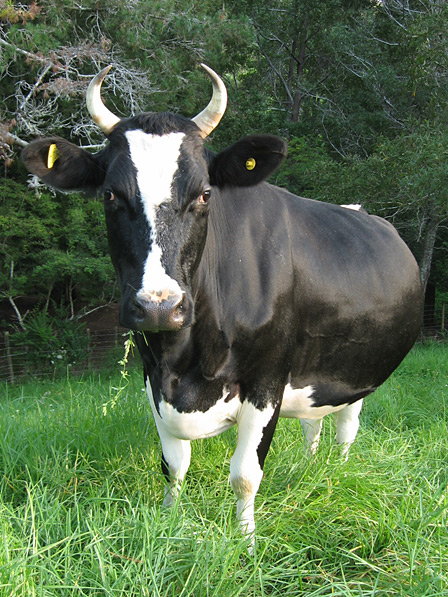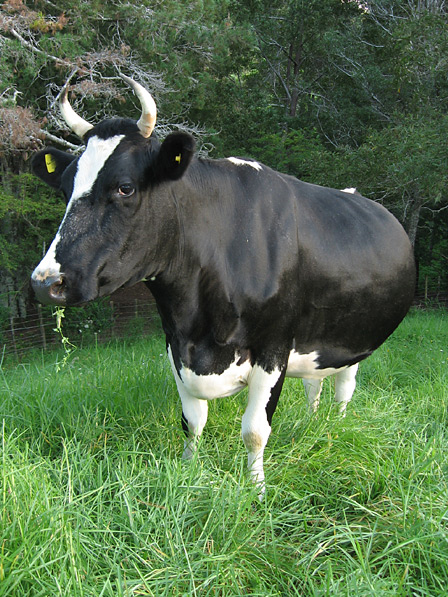Esmerelda, our Friesian cow, is growing incredibly large. I’m beginning to wonder if the Ambler’s calf, growing inside her, is going to spring forth fully formed!? We don’t think Esmerelda is due to calve until July, so how much bigger will she get?
I was out the other day, inspecting the boundary fences, and I snapped some images of our glorious (and strident) beast in the evening light.
In photography school, I learned how to use the evening sky as a massive softbox. Just wait for the sun to go below the horizon in the evening and you’ll have several minutes of warm light that flatters most subjects. Glossy car brochure photos are the most common examples of this technique. Let’s see how well it works on a cow the size of a minivan.

I’m ready for my closeup

Will that lens make me look fat?
How about a name that calf contest? Yhe highest
bidder gets to name the calf. Think about it.
Hmm. Well… Uh… Those calves aren’t going to be around too long, if you know what I mean. This will not be an easy time on the Farmlet. But nobody said it was going to be easy.
Didn’t realize you’d attended Brooks, Kevin. Though it does explain your consistently solid framing and overall use of composition. I’ve spent many a happy day exploring via lens and aperture myself, though a stint at Brooks (or Rochester) never materialized for reasons beyond the scope of this comment.
“Magic light” or not, that is one fine, proud and shiny cow with calf. I’d rather have her than a minivan anyday. And while the calf may not reside long on the Farmlet pastures, with it will arrive that long-awaited bounty — your first raw milk production right there on the homestead.
What’s Rebecca have in mind for the colostrum?
As I continue renovation work on our old stable spaces over the next couple years, which once housed as many as 80 head of dairy cattle, pens to handle a pair of cows, pigs, goats and eventually (I suspect) a horse will take shape alongside my workshop and a few other amenities aimed at converting the place into a B&B of sorts.
As we add new orchard to the back slope of the main property this year, I’ll build my first portable, stand-alone chicken coops for our local hens, so they can forage in either of the orchards. Their tasty eggs are a popular staple we share out among friends and family, as we currently produce far more than we consume (not for lack of trying), and each time we visit siblings and other relations, our care packages of farm fresh “Eier” and other garden glories (in season) are much appreciated.
I’ve stood on the sidelines of several calvings in recent years, and you’re in for quite a new experience, my fellow expatriate. A messy affair, but still quite positive annd life affirming.
Then there’s the other (dark) side, the slaughtering aspect, which should be done with as gently as possible while exercising humanity, respect and exuding thankfulness. I’ll need to perform said duty with the older of our two current broods of chickens early next year. From death emerges life and all that jazz, but it doesn’t make the blood and guts any easier.
You got name the calf Porter. (I’ve heard of this.)
Or Bartholemew. Or Fajitas. Are you planning on keeping
the (searching for word . .) baby girl cows? Are you
putting back hay for the winter? More details man.
http://youandyouroilthing.blogspot.com/
Yeah, Brooks. I didn’t graduate from there. I quit because people (graduates of the place) who were much better than me at photography were bagging groceries at Vons (supermarket). I didn’t love photography enough to make a living at it doing the type of stuff I liked (photojournalism). I shot weddings when I needed money, but I had to drink my way through those jobs. Like many things, I enjoy photography much more when the pressure is off, rather than on.
I use the old “trigger discipline” I had when I shot 35mm, even with digital. Ansel Adams thought that having a roll of film that allowed for 24 or 36 exposures made photographers sloppy. How about with digital?!
When I started shooting digital I was shocked by how crappy my results were. It wasn’t the consumer level digital gear I was using, which, admittedly, doesn’t provide anything like the control you get from a decent 35mm SLR. (I used an abused a Canon EOS 1 from 1991 until I sold it in 2006.) It was just the trigger happy, spray and pray method. I wasn’t seeing subjects. I was hurrying too much for that, as with everything else in life.
Life on the Farmlet is good in lots of ways. And I have the time to take nice pictures again. I dream of having access to one of the digital iterations of the EOS1. But even the first generation EOS1D bodies cost about US$1000 used, and I sold all of my lenses to assist with the Farmlet purchase. (People always told me: “Boy, don’t ever sell your glass.”) I have a lot of fun, though, with the little Canon soapbox point and shoot thing we’ve got now. It’s remarkable, really.
@ Michelle
We liked Brisket, Ribs and Mince (mince is what Kiwis call hamburger) sounded good…
If we get heifers, there’s a chance that we would be able to sell them to Becky’s cousin, but he runs a “real” dairy farm with very real obligations to very evil banks. In other words, our mongrel heifers, might not grow into suitable producers for a commercial dairy operation. (Ambler, the sire, is an Angus bull, a meat breed.)
Since we aren’t pushing our pasture very hard, we don’t make hay while the sun shines. We are guessing that we have plenty of grass on the pastures, plus more down the front of our property that could be used if we overshot our calculations. The cold of winter slows grass growth down here, but it’s pretty mild overall. When we moved on to this land, there were two steers who weren’t able to eat all the grass down, even over winter.
We are rotating the cows over several paddocks. This greatly extends the amount of grass available, and improves the quality of the grass.
You need to strike a balance with animals on the pasture. Not enough animals and you’ll get too much grass that winds up rotting. Too little grass/too many animals, and you have to bring in hay at great expense, and erosion could wreck your pasture.
Of course, we could be really off. People who know better, though, think that we’ll probably be ok over winter. Most, maybe all, commercial operations will be stockpiling silage in massive, round plastic-wrapped units.
Since we’re not working for any banks, we can run things at a much less intense and (we think) sane and healthy level.
Well, there’s always “Junior.” As in, “Doesn’t Junior taste good?!”
Ah… traumatic childhood memories… they stay with you forever.
What magnificent photographs of your magnificent cow. We farm Charolais cows and they are just calving at the moment. When your cow does calve will she calve in the field or will you bring her into a barn incase she needs assistance?
I will be visiting your site again for more updates on the cows.
Sara from farmingfriends in the UK
Hi Sara,
We were planning to leave the cows in the field, since that’s what everyone else seems to do around here. We’re not even exactly sure of their due dates, so it’s very possible we’ll be taken by surprise. We plan to keep a close eye on them as the time draws near, just in case any problems crop up.
We think Charolais are splendid looking animals, by the way. There are some along the road that we admire whenever we drive past! Good luck with your cows and their calves, and thanks for your comment.
Rebecca